线粒体靶向过氧化麦角甾醇衍生物的合成、抗癌特性及其抑制MCF-7细胞增殖的初步机制
IF 1.3
4区 化学
Q3 CHEMISTRY, MULTIDISCIPLINARY
引用次数: 1
摘要
过氧化麦角甾醇(Ergosterol peroxide, EP)因其抗肿瘤活性而被广泛研究。然而,由于其细胞内蓄积有限和水溶性差,其进一步发展受到限制。在这项研究中,一个新的三苯基磷离子(TPP+)片段偶联到麦角甾醇过氧化氢,以精确靶向肿瘤细胞线粒体。合成的Mito-EP衍生物Mito-EP-3a-3d表现出比EP亲本更强的细胞毒性,并在癌细胞和正常胃上皮细胞(gs -1)之间表现出选择性的细胞毒作用。最有效的化合物Mito-EP-3b在MCF-7(乳腺癌)细胞系中的有效性是过氧化麦角甾醇的9.7倍,并表现出良好的选择性(SI = ic50ge -1/IC50MCF-7 = 4.04, IC50:浓度抑制50%的细胞生长)。此外,Mito-EP-3b能够降低线粒体膜电位,诱导活性氧产生,同时激活细胞色素c和Bax的表达,而抑制Bcl-2的表达。其分子机制可能与线粒体凋亡途径有关。总的来说,上述结果激励了进一步研究Mito-EP-3b衍生物作为有效的抗癌剂。本文章由计算机程序翻译,如有差异,请以英文原文为准。
Mitochondria-Targeted Ergosterol Peroxide Derivatives: Synthesis, Anticancer Properties and Their Preliminary Mechanism of Inhibiting MCF-7 Cell Proliferation
Ergosterol peroxide (EP) has been extensively studied for its antitumor activities. However, its further development has been restricted due to its limited intracellular accumulation and poor aqueous solubility. In this study, a novel triphenylphosphonium cation (TPP+) moiety was coupled to ergosterol peroxide to precisely target it at tumor cell mitochondria. The synthesized Mito-EP derivatives Mito-EP-3a-3d displayed stronger cytotoxicity than the EP parent and exhibited selectively cytotoxic effects between cancer cells and normal gastric epithelial (GES-1) cells. The most potent compound, Mito-EP-3b, was 9.7-fold more efficacious than ergosterol peroxide in the MCF-7 (breast cancer) cell line and showed good selectivity (SI = IC50GES-1/IC50MCF-7 = 4.04, IC50: concentrations to inhibit 50% of cell growth). Furthermore, Mito-EP-3b was able to decrease the mitochondrial membrane potential and induced reactive oxygen species production, accompanied by activating the expression of cytochrome c and Bax, while Bcl-2 expression was suppressed. The molecular mechanism may refer to the mitochondrial apoptotic pathway. Overall, the above results incentivize the further study of Mito-EP-3b derivatives as potent anticancer agents.
求助全文
通过发布文献求助,成功后即可免费获取论文全文。
去求助
来源期刊
CiteScore
2.90
自引率
7.10%
发文量
99
审稿时长
3.4 months
期刊介绍:
The Journal of the Brazilian Chemical Society embraces all aspects of chemistry except education, philosophy and history of chemistry. It is a medium for reporting selected original and significant contributions to new chemical knowledge.

 求助内容:
求助内容: 应助结果提醒方式:
应助结果提醒方式:


